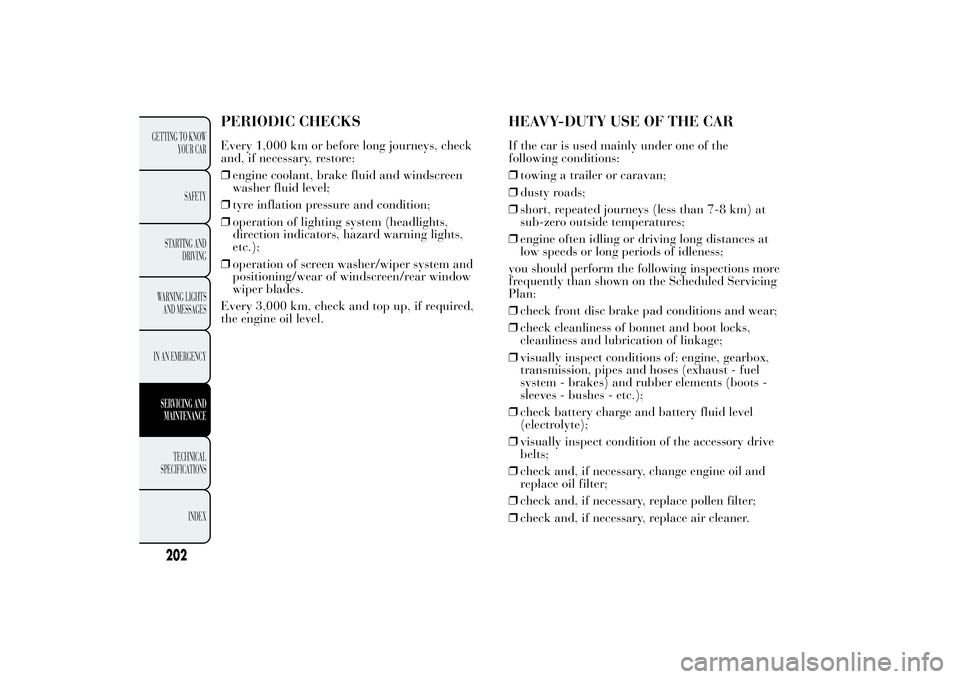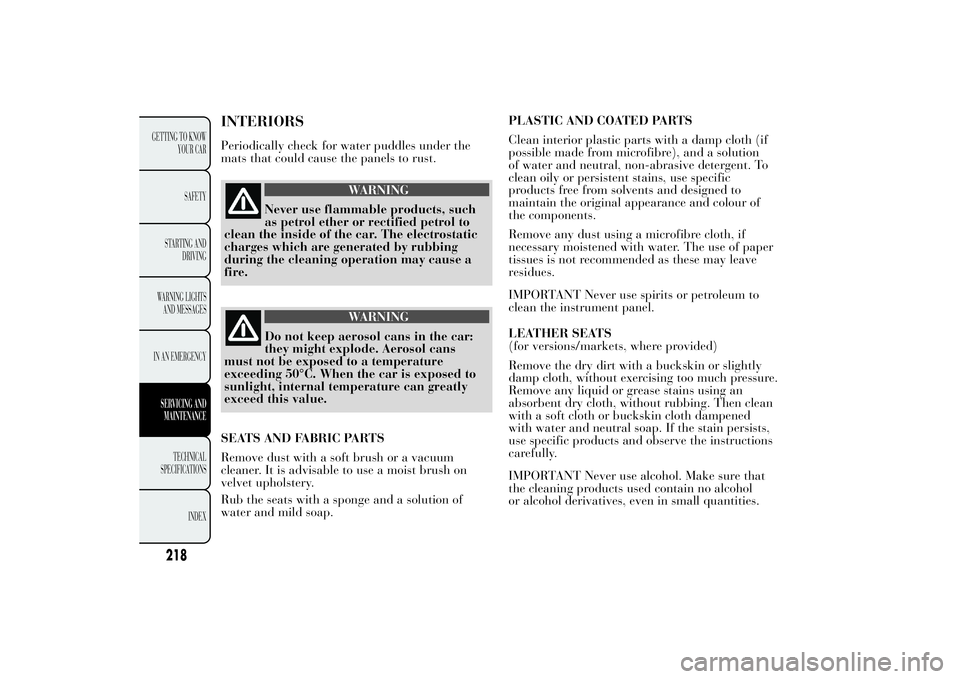oil pressure Lancia Ypsilon 2011 Owner handbook (in English)
[x] Cancel search | Manufacturer: LANCIA, Model Year: 2011, Model line: Ypsilon, Model: Lancia Ypsilon 2011Pages: 299, PDF Size: 13.35 MB
Page 147 of 299

WARNING
A failure of the
warning light is
indicated by warning light
switching on. In addition, the airbag
system automatically disables the airbags on
the passenger's side (both front and side
airbags where provided). Before continuing,
contact a Lancia Dealership immediately
to have the system checked.
UNFASTENED SEAT BELTS (red)
(for versions/markets, where provided)
The warning light switches on constantly with the
car stationary and the driver's side or passenger
side seat belt (when the passenger is present)
not fastened. The warning light will flash and a
buzzer will sound if the car is in motion and
the front seat belts are not correctly fastened.
Contact a Lancia Dealership if you wish to
permanently deactivate the S.B.R. (Seat Belt
Reminder) system buzzer. The system can be
reactivated using the Setup menu (see the
description in the chapter "Knowing your car").
LOW BATTERY CHARGE (red)
(for versions/markets, where provided)
When the ignition key is moved to MAR, the
warning light switches on but should switch off as
soon as the engine is started (with the engine
idling, a brief delay can be expected).
If the warning light (or, on some versions, a
message and a symbol on the display) remains on
constantly or flashing, contact a Lancia
Dealership.CONTINUOUSLY ON: LOW ENGINE
OIL PRESSURE (red)
ON FLASHING: ENGINE OIL
DETERIORATED
(only Diesel versions with DPF - red)
When the ignition key is moved to MAR, the
warning light switches on but should switch off as
soon as the engine is started.
1. Insufficient engine oil pressure
The warning light switches on constantly together
(for versions/markets, where provided) with a
message on the display when the system detects
that the engine oil pressure is too low.
145GETTING TO KNOW
YOUR CAR
SAFETY
STARTING AND
DRIVINGWARNING LIGHTS
AND
MESSAGESIN AN
EMERGENCY
SERVICING AND
MAINTENANCE
TECHNICAL
SPECIFICA
TIONS
INDEX
Page 154 of 299

Dusk sensor failure
(for versions/markets, where provided)
The warning light switches on (together with a
message on the display) when a dusk sensor
failure is detected.
Engine oil pressure sensor failure
Versions with multifunction display:the engine oil
pressure sensor failure is indicated by the
instrument panel warning light switching on.
Versions with reconfigurable multifunction
display:the engine oil pressure sensor failure is
indicated by the display icon switching on.
EXTERNAL LIGHT FAILURE
(amber)
This warning light switches on (on some versions
together with a message and a symbol in the
display) if a fault is detected in one of the
following lights:
❒daylight lights (DRL);
❒side lights;
❒direction indicators;
❒rear fog lamps;
❒number plate lights;
❒brake lights (for versions with multifunction
display only).The failure relating to these lights could be: one or
more blown bulbs, a blown protection fuse or a
break in the electrical connection.
REAR FOG LIGHTS (amber)
The warning light switches on when the rear fog
lights are activated. The LED over the button
will also light up.
FRONT FOG LIGHTS (green)
The warning light comes on when the front fog
lights are turned on. The LED over 5 button
will also light up.
152
GETTING TO KNOW
YOUR CAR
SAFETY
STARTING AND
DRIVINGWARNING LIGHTS
AND
MESSAGESIN AN
EMERGENCY
SERVICING AND
MAINTENANCE
TECHNICAL
SPECIFICA
TIONS
INDEX
Page 204 of 299

PERIODIC CHECKSEvery 1,000 km or before long journeys, check
and, if necessary, restore:
❒engine coolant, brake fluid and windscreen
washer fluid level;
❒tyre inflation pressure and condition;
❒operation of lighting system (headlights,
direction indicators, hazard warning lights,
etc.);
❒operation of screen washer/wiper system and
positioning/wear of windscreen/rear window
wiper blades.
Every 3,000 km, check and top up, if required,
the engine oil level.
HEAVY-DUTY USE OF THE CARIf the car is used mainly under one of the
following conditions:
❒towing a trailer or caravan;
❒dusty roads;
❒short, repeated journeys (less than 7-8 km) at
sub-zero outside temperatures;
❒engine often idling or driving long distances at
low speeds or long periods of idleness;
you should perform the following inspections more
frequently than shown on the Scheduled Servicing
Plan:
❒check front disc brake pad conditions and wear;
❒check cleanliness of bonnet and boot locks,
cleanliness and lubrication of linkage;
❒visually inspect conditions of: engine, gearbox,
transmission, pipes and hoses (exhaust - fuel
system - brakes) and rubber elements (boots -
sleeves - bushes - etc.);
❒check battery charge and battery fluid level
(electrolyte);
❒visually inspect condition of the accessory drive
belts;
❒check and, if necessary, change engine oil and
replace oil filter;
❒check and, if necessary, replace pollen filter;
❒check and, if necessary, replace air cleaner.
202
GETTING TO KNOW
YOUR CAR
SAFETY
STARTING AND
DRIVING
WARNING LIGHTS
AND MESSAGES
IN AN EMERGENCYSERVICING AND
MAINTENANCE
TECHNICAL
SPECIFICA
TIONS
INDEX
Page 220 of 299

INTERIORSPeriodically check for water puddles under the
mats that could cause the panels to rust.
WARNING
Never use flammable products, such
as petrol ether
or rectified petrol to
clean the inside of the car. The electrostatic
charges which are generated by rubbing
during the cleaning operation may cause a
fire.
WARNING
Do not keep aerosol cans in the car:
they might explode.
Aerosol cans
must not be exposed to a temperature
exceeding 50°C. When the car is exposed to
sunlight, internal temperature can greatly
exceed this value.
SEATS AND FABRIC PARTS
Remove dust with a soft brush or a vacuum
cleaner. It is advisable to use a moist brush on
velvet upholstery.
Rub the seats with a sponge and a solution of
water and mild soap.PLASTIC AND COATED PARTS
Clean interior plastic parts with a damp cloth (if
possible made from microfibre), and a solution
of water and neutral, non-abrasive detergent. To
clean oily or persistent stains, use specific
products free from solvents and designed to
maintain the original appearance and colour of
the components.
Remove any dust using a microfibre cloth, if
necessary moistened with water. The use of paper
tissues is not recommended as these may leave
residues.
IMPORTANT Never use spirits or petroleum to
clean the instrument panel.
LEATHER SEATS
(for versions/markets, where provided)
Remove the dry dirt with a buckskin or slightly
damp cloth, without exercising too much pressure.
Remove any liquid or grease stains using an
absorbent dry cloth, without rubbing. Then clean
with a soft cloth or buckskin cloth dampened
with water and neutral soap. If the stain persists,
use specific products and observe the instructions
carefully.
IMPORTANT Never use alcohol. Make sure that
the cleaning products used contain no alcohol
or alcohol derivatives, even in small quantities.
218
GETTING TO KNOW
YOUR CAR
SAFETY
STARTING AND
DRIVING
WARNING LIGHTS
AND MESSAGES
IN AN EMERGENCYSERVICING AND
MAINTENANCE
TECHNICAL
SPECIFICA
TIONS
INDEX